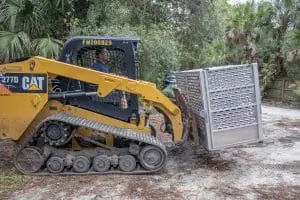

Florida black bear Brody recently received a CT scan to check on his anatomy.
When our CT became fully functional last year, there was one animal resident who was at the top of our veterinary team’s list for a scan: 3-year-old Brody the Florida black bear.
Brody didn’t have an easy start to his life. Found without his mom at just a few weeks old, he dealt with a number of health issues in his first two years of life. At about 5 months old, he was diagnosed with a condition similar to hip dysplasia and underwent a first-of-its-kind surgical procedure to correct this issue. Though the surgery and following stem-cell therapy showed promise, he still occasionally shows mobility issues following overexertion that seemingly resolves itself.
Now, nearly 3 years after the pelvic surgery, our veterinary team wanted to use the CT to get a more detailed picture of Brody’s current anatomy.
 A CT onsite makes providing this level of care to our animal residents easier than bringing them offsite to a human or veterinary hospital. Still, it’s no simple thing to move a 400-plus-pound bear out of his normal habitat to our L3 Harris Animal Care Center!
A CT onsite makes providing this level of care to our animal residents easier than bringing them offsite to a human or veterinary hospital. Still, it’s no simple thing to move a 400-plus-pound bear out of his normal habitat to our L3 Harris Animal Care Center!
Our animal care team has been working with Brody and our two female Florida black bears Betty and Cheyenne on voluntary injection training along with other behaviors that help the trio be a part of their own care at our Zoo. With the addition of Brody’s surrogate “mom,” director of animal programs Lauren Hinson, Brody was calm during the initial sedative injection and moved into his secure carrier. The metal carrier was carted to the hospital by a member of our construction team using a loader.
Once he arrived, Brody was carried out of the carrier by more than a few members of his animal care team and our veterinary staff. From there, a full check-up was done along with castration.
Then, it was time for the CT. Another lift from all our staff brought Brody to the table, and several scans were taken. The images were sent to a radiologist for interpretation.
Recently, the radiology report came back normal. We’re unsure what, if any, long-term consequences there may be from his abnormalities, but our animal care teams will continue to monitor Brody for any significant changes. We’re thankful to be able to provide Brody and all our animal residents with this level of care!
See a video of the process on YouTube: https://youtu.be/_Km2pfjdDMA.
Brevard Zoo is an independent, not-for-profit organization that receives no recurring government funding for our operating costs. Your generous support enables us to continue to serve our community and continue our vital animal wellness, education and conservation programs.